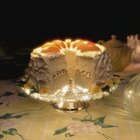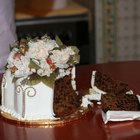
When baking instructions include cooling, that usually means letting your dish sit on a counter until it reaches room temperature. This is exactly what you need to do when a cake recipe reminds you to cool the layers thoroughly before frosting. No refrigeration is needed. Refrigerating cake layers can cause problems that make it hard to frost a cake. So cool it on the counter, and frost away.
What Cooling Accomplishes
With or without plans to frost, cooling lets the cake layers form a smooth outer crust, letting you handle the layers without fear of their crumbling or breaking. A cake straight out of the oven has a crumbly, soft crust that would mix with frosting and tear the cake. Cooling also lets steam dissipate from within the cake. This brings it to the desired moist but not damp consistency.
Refrigeration Problems
A cooling cake undergoes some compacting of surface crumbs, or crusting. Space constraints and the humidity in your refrigerator make crusting difficult. In an old-fashioned refrigerator with wire shelves, cold air could circulate under cake racks, but modern solid shelves make that impossible. Steam cannot rise easily in cold, refrigerated air, so cake layers may remain damp. Steam that does rise impacts on other items you are storing in the refrigerator.
Frosting Too Fast
A warm cake presents two additional problems if hastily frosted. A butter-based frosting will melt, running off or soaking into the cake, leaving a mess. A cooked glaze or frosting may be less runny but can trap steam inside the cooling cake, leaving a sunken middle or pasty-textured center.
Cake Cooling Techniques
To speed cooling, place the cake pans coming out of the oven on footed racks in a draft-free area. This lets air circulate under the pans and speeds cooling and crusting. If you don't have racks, you can set pans on a cutting board covered with a dish towel, propping one edge up slightly with a spoon for a little air circulation. You can also improvise a rack by placing three shallow cans, like those for tuna or sardines, in an open triangle on the counter. Angel food, sponge and fluted cakes need to be cooled with their pans upside down. If your pan does not have cooling prongs, use the can triangle or slide the pan over the neck of a heatproof glass bottle to cool.
Removal from Pans
After 10 minutes, run a table knife around the edge of the pan. Place a dish towel over the cake layer and the rack on top. Invert the covered pan and remove it gently, leaving the cake layer to finish cooling for another 30 minutes on the towel-covered rack. Allow a full hour for angel food, sponge or fluted cakes to cool.
Ready for Frosting
Brush loose crumbs gently from the cake's surface. To keep crumbing to a minimum, wrap cake layers individually in plastic wrap, then place each on in a resealable plastic bag. Put layers in the coldest part of your freezer for four to 24 hours, then frost.
Related Articles

Can You Frost a Cracked Cheesecake?

How to Keep Frosting Moist

Storage for a Sheet Cake With Whipped ...

How to Cool Brownies Quickly
What Causes My Cake to Fall When ...

How to Freeze Decorated Yule Log Cakes

How to Freeze Cakes Before Frosting

How to Defrost a Frozen Cake With ...

Baking a Cake on Top of Wax Paper

How to De-Pan an Angel Food Cake

How to Make a Cruise Ship-Shaped Cake

Should You Frost a Frozen Cake or Wait ...
How Long Can Leftovers Be Refrigerated?

How Early Can You Make a Wedding Cake?

How to Freeze Pavlova

How Long Does Peanut Brittle Take to ...

Easiest Way to Remove a Stuck Bread ...

How to Delay the Baking of Homemade ...

How to Use Sugaring Paste on Your Upper ...

How Long Before an Event Should I Bake ...
References
Writer Bio
Janet Beal has written for various websites, covering a variety of topics, including gardening, home, child development and cultural issues. Her work has appeared on early childhood education and consumer education websites. She has a Bachelor of Arts in English from Harvard University and a Master of Science in early childhood education from the College of New Rochelle.
Photo Credits
Ryan McVay/Stockbyte/Getty Images